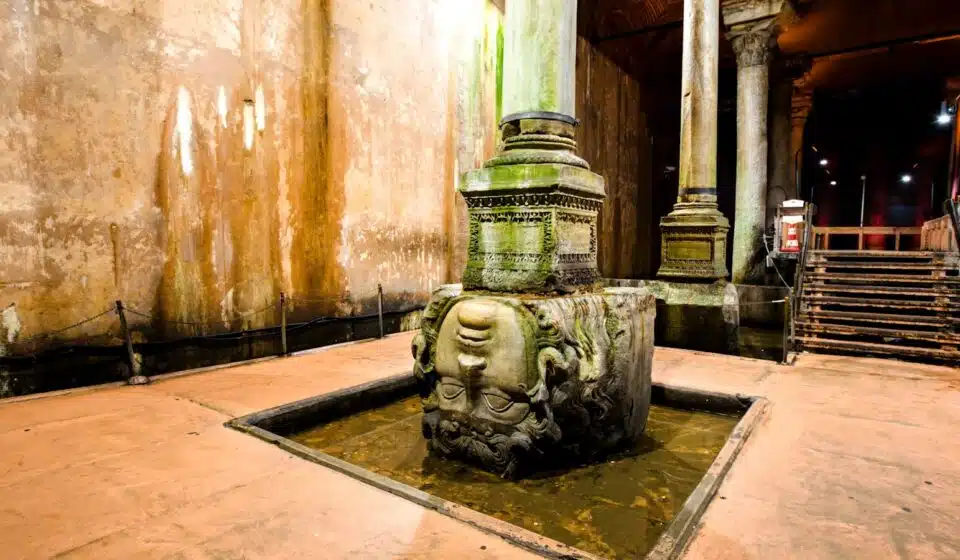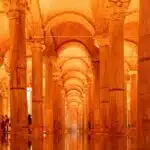
Mythology and Legends Surrounding the Basilica Cistern
Deep beneath the vibrant streets of Istanbul lies a place that feels more like myth than reality — the Basilica Cistern. With its shadowy columns, echoing water drips, and eerie stillness, it’s no surprise this underground wonder has inspired countless myths, legends, and ghost stories. From ancient Greek curses to modern-day film appearances, the cistern blurs the line between history and imagination.
Medusa and Her Connection to the Cistern
One of the most iconic and mysterious symbols in the Basilica Cistern is the presence of two Medusa heads, used as column bases. According to Greek mythology, Medusa was a Gorgon — a creature with snakes for hair whose gaze could turn anyone to stone.
But what is Medusa doing in a Byzantine-era water reservoir?
Some believe her image was used deliberately, meant to protect the cistern by warding off evil spirits. Others think the heads were simply recycled from pagan temples, and their strange sideways and upside-down positioning was either symbolic or merely practical.
Still, for visitors today, the Medusa heads exude a dark, mysterious energy — especially as their faces remain half-submerged in shallow water, eternally gazing into the depths.
The Hidden Tears of the Cistern
Among the many intricately carved columns in the cistern, one stands apart — the “Hen’s Eye” or “Weeping Column.” Decorated with peacock eye motifs and carved teardrops, this column is believed to be a tribute to fallen slaves or workers who died during the construction of the cistern.
Legends say the column “weeps” out of sorrow, and visitors often pause here to make a wish or touch its base for good luck. The moisture that continuously glistens on the stone adds to the legend’s emotional pull, reinforcing the idea that the cistern itself remembers its tragic origins.
The Lost City of Atlantis — Hidden Beneath Istanbul?
It might sound far-fetched, but some wild theories have even linked the Basilica Cistern to Atlantis, the mythical lost city described by Plato. This theory, often popularized by conspiracy theorists and adventure novelists, suggests that Istanbul’s underground architecture — especially the grand, symmetrical columns of the cistern — could be a surviving remnant of a lost ancient civilization.
While there’s no historical basis for this theory, the otherworldly ambiance of the cistern makes it a ripe setting for such speculation. The dim lighting, endless arches, and mysterious Medusa only add fuel to the fire of imaginative storytelling.
Ghost Stories and Paranormal Activity
Locals and nighttime visitors have often spoken of strange whispers, cold chills, and ghostly figures appearing in the dimly lit walkways of the cistern. Some believe the spirits of workers who died during the cistern’s construction still linger beneath the surface.
Others say that the upside-down Medusa curses those who mock her, while the weeping column is a portal to another realm. Though no official hauntings have been confirmed, the environment of the cistern — silent, cold, and echo-filled — makes it a perfect backdrop for ghost tales.
Impact on Popular Culture and Media
The Basilica Cistern has not only inspired myths — it has captured the imagination of artists, writers, and filmmakers across the world. Most famously, it was featured in:
- Dan Brown’s novel Inferno and its film adaptation (2016), where a dramatic chase scene unfolds in the dark corridors of the cistern.
- Documentaries and travel shows exploring “Haunted Places” or “Hidden Wonders” of the world.
- Numerous fantasy novels and video games, where secret chambers, ancient curses, or magical artifacts are hidden underground — inspired by places like the Basilica Cistern.
Its cinematic ambiance, dramatic lighting, and mythological touches make it a living legend that continues to influence modern pop culture.
Conclusion
The Basilica Cistern is more than an architectural wonder — it’s a place where myth, legend, and reality intertwine. From the petrifying gaze of Medusa to the whispered tears of lost souls, every drop of water and shadowed column seems to echo a forgotten story.
Whether you believe in ghosts or simply love history with a twist of magic, the legends of the Basilica Cistern offer an unforgettable experience — one that lingers long after you’ve climbed back to the surface.

